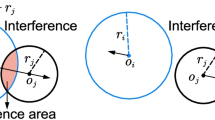Abstract
In modern work units, industrial robots have been widely utilized to perform various operations, like welding, assembly and carrying etc. Facing a fixed operating space, how to determine the initial standing pose of the robot has been a significant problem for real applications, which will largely affect the robotic flexibility to arrive operating targets. For this problem, this work presented a spatial layout method of the robot relative to the known operating space through the workspace simulation of the robot based on screw theory and Monte Carlo method. In this method, the feature of the robotic workspace is analyzed based on the simulation, based on which the workspace volume is modeled and optimized considering the size of the operating tool. During the layout, layout variables, including translation distances in three axial directions and the rotational angle about the z axis of the robotic origin base frame, are modeled relative to the known operating space. The effectiveness of the proposed method is validated using a simulation example. Results show that the flexible workspace of the robot can better contain the known operating space after the adjustment of the robotic standing pose. This method will provide an important theoretical foundation for the real layout of work units.
Access this chapter
Tax calculation will be finalised at checkout
Purchases are for personal use only
Similar content being viewed by others
References
Xu, Z.B., et al.: Improvement of Monte Carlo method for robot workspace solution and volume calculation. Opt. Precis. Eng. 26(11), 2703–2713 (2018)
Zhao, Y., et al.: A method for solving robot workspace based on Matlab. Mech. Sci. Technol. Aerosp. Eng. 28(12), 1657–1661 (2009)
Wagner, M., et al.: Reachability analysis for cooperative processing with industrial robots. In: 2017 22nd IEEE International Conference on Emerging Technologies and Factory Automation (ETFA), Limassol, pp. 1–6 (2017)
Gotlih, K., et al.: Velocity anisotropy of an industrial robot. Robot. Comput. Integr. Manuf. 27(1), 205–211 (2011)
Jian, Y.Y.: Working space and dexterity analysis and application for 6-DOF industrial robots. Ph.D. thesis, Huazhong University of Science and Technology (2015)
Ma, R.R., Zhang, H.H.: The analysis and research on dexterity of 6R type arc welding robot based on flexibility. J. Changchun Univ. Sci. Technol. (Nat. Sci. Edn.). 37(05), 64–68 (2014)
Aly, M.F., Abbas, A.T., Megahed, S.M.: Robot workspace estimation and base placement optimisation techniques for the conversion of conventional work cells into autonomous flexible manufacturing systems. Int. J. Comput. Integr. Manuf. 23(12), 1133–1148 (2010)
Zhuo H.L..: The optimization of robotic cellular layout by the improved practical swarm optimization algorithm. Ph.D. thesis, Huazhong University of Science and Technology (2017)
Kats, V., Lei, L., Levner, E.: Minimizing the cycle time of multiple-product processing networks with a fixed operation sequence, setups, and time-window constraints. Eur. J. Oper. Res. 187(3), 1196–1211 (2008)
Alim, A.M., et al.: Robot workcell layout optimization using firefly algorithm. In: Swarm Evolutionary and Memetic Computing, pp. 188–200 (2015)
Xu, J.J., et al.: Models for three new screwbased IK sub-problems using geometric descriptions and their applications. Appl. Math. Model. 67(1), 399–412 (2018)
Sariyildiz, E.: A new formulation method for solving kinematic problems of multiarm robot systems using quaternion algebra in the screw theory framework. Turk. J. Electr. Eng. Comput. Sci. 20(4), 607–628 (2012)
Chen, Q., et al.: Improved inverse kinematics algorithm using screw theory for a six-DOF robot manipulator. Int. J. Adv. Robot. Syst. 12(10), 140 (2015)
He, J.W., Ping, X.L., Li, Z.Y., Jiang, Y.: Research and application of the solving method for robotic workspace. J. Mech. Transm. 39(10), 68–71 (2015)
Fu, B., et al.: The solution of robot manipulator’s collision free workspace based on Monte Carlo method. Mod. Mach. Tool Autom. Manuf. Techn. 2(2), 16–19 (2016)
Bi, Z.M.: Analysis and synthesis of robotic posture space. Mech. Sci. Technol. 15(1), 11–16 (1996)
Acknowledgement
This work was supported by National Natural Science Foundation of China (51805012); National Science and Technology Major Project (2018ZX04032002); Beijing Postdoctoral Foundation Class A of China(No. Q6001211202101 and No. 6001211202102); Beijing Nova Programme Interdisciplinary Cooperation Project (Z191100001119010).
Author information
Authors and Affiliations
Corresponding author
Editor information
Editors and Affiliations
Rights and permissions
Copyright information
© 2021 Springer Nature Switzerland AG
About this paper
Cite this paper
Wang, J., Li, L., Liu, Z., Xu, J., Yang, C., Cheng, Q. (2021). A Spatial Layout Method of Robots Relative to Operating Space Based on Its Flexible Workspace Simulation. In: Liu, XJ., Nie, Z., Yu, J., Xie, F., Song, R. (eds) Intelligent Robotics and Applications. ICIRA 2021. Lecture Notes in Computer Science(), vol 13013. Springer, Cham. https://doi.org/10.1007/978-3-030-89095-7_1
Download citation
DOI: https://doi.org/10.1007/978-3-030-89095-7_1
Published:
Publisher Name: Springer, Cham
Print ISBN: 978-3-030-89094-0
Online ISBN: 978-3-030-89095-7
eBook Packages: Computer ScienceComputer Science (R0)




